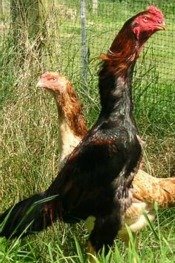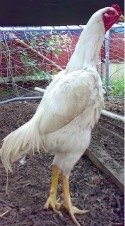Shamo Chickens: The Tall, Athletic Breed
Shamo Chickens are known for being the second tallest breed. They stand very upright and are making a name for themselves with show enthusiasts.
Shamo Chickens The Facts:
Class: Standard: All Other Standard Breeds Bantam: All Other Combs, Clean Legged
Size: Standard Male: 11 Ibs. / Standard Female: 7 Ibs. / Bantam Male: 44 oz. / Bantam Female: 35 oz.
Comb, Wattles & Earlobes: They have a small pea comb and earlobes. The wattles are very small or missing entirely. They are all bright red.
Color: The beak is yellow and the eyes are pearl with yellow shanks and toes.
Black: They have standard black plumage.
Black-Breasted Red: They have standard black-breasted red plumage.
Brown Red: They have standard brown-red plumage.
Buff Columbian: They have standard buff Columbian plumage.
Dark: They have standard dark plumage.

Spangled: They have standard spangled plumage.
Wheaten: They have standard wheaten plumage.
White: They have standard white plumage.
Place of Origin: Japan
Conservation Status: Study
Special Qualities: They stand very upright and are becoming popular on the show circuit.
They measure about 30 inches tall, and clock in as the second tallest breed of chicken. They are an ancient breed who originated in Japan.
Quite a few of the domestic Japanese breeds have came out of crossing Shamo Chickens, such as the Yokohama and the Phoenix. The breed was first imported to the United States in 1874. It is a protected species in Japan.

They have very short hard feathers that may not fully cover the body. They also have a beetle brow, like the Malay, who they share common ancestry with. They also have no feathers on their face or throat and roughly textured facial skin.
These birds are very aggressive fighters and the chicks begin to fight almost immediately after birth. The cocks must be separated to prevent them from fighting to the death.
The birds do like humans though, and with the correct care from a young age can be domesticated and tamed down rather easily. The hens are excellent mothers and lay more eggs than many of the other Asiatic game breeds.
The breed was first recognized by the APA in 1981.

Custom Search



New! Comments
Have your say about what you just read! Leave me a comment in the box below.